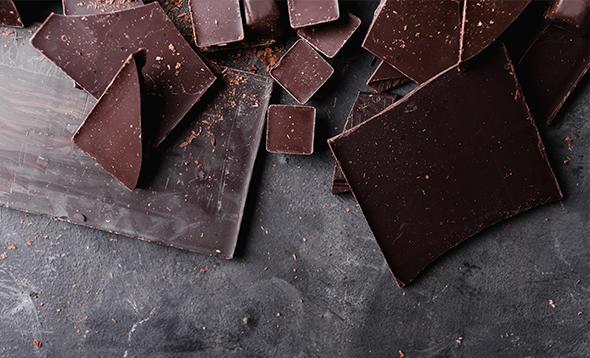That organic living is a conscious health choice
Choosing Healthful Chocolates
Cheers to chocolate! The confection my clients confess to craving above all other indulgences offers some serious health perks.
While most people regard chocolate as a guilty pleasure, few know that it’s a great source of catechins – phytochemicals that are proven to have positive effects on blood circulation, cholesterol levels, memory, blood pressure and sugar control, and even our skin!
But with the abundance of bars, bites, powders and chips, choosing chocolate can be a baffling endeavour. How do you separate standout products from those with less nutritional benefit? Here are some key nutrition considerations to keep in mind the next time you’ve got cocoa cravings.
Processing and Potency
Cacao and cocoa are often used interchangeably, but they are not one and the same. The difference lies in how they’re processed. Cacao refers to the raw, natural extracts from the cacao bean, while cocoa is treated at high temperatures, resulting in a softer, slightly sweeter flavour.
Both cacao and cocoa contain considerable amounts of heart-healthy flavanols. However as these precious phytochemicals are sensitive to heat, amongst other factors, cocoa has less of it as compared to its less processed counterpart.
In addition, some chocolate companies employ the Dutch process by treating cacao or cocoa extracts with alkalising agents to give chocolate a darker colour and milder, less bitter flavour. This process can reduce the flavanol concentration of chocolate by 60 to 90 per cent. While not a global regulation, the Unites States has regulations in place to ensure that chocolates that have been processed with alkali are labelled as such.
Playing the Percentages
When purchasing chocolates, the percentages you see on the front packaging matters. For a health boost without derailing weight control efforts, aim for the most phytochemicals with the least calories.
In chocolate production, the cacao fruit is cracked open and the butters are separated from the rest of the bean. Often sold as powders or nibs, 100 per cent raw, unsweetened cacao contains just cacao bean extracts - without the butters. It offers the most fibre, nutrients and antioxidants. However, its pungent bitter flavour may be too strong for the untrained palate.
Dark chocolates and milk chocolates bring butters back into the equation, and sometimes add on other ingredients such as sweeteners, dairy or flavourings. These additions dilute the amount of actual cacao in the end product. The percentages on the packaging indicate how much of your chocolate is actually from cacao – the extracts and the butters, or cocoa if the beans have been roasted. Aim for 70 per cent or more for a healthful sweet treat that pleases your palate – and your body!
Add-in Awareness
As raw, unadulterated cacao has a strong, bitter flavour, companies often incorporate other ingredients to make it more palatable and to set their products apart from their competitors. While most inclusions offer a nice texture or flavour, not all have desirable nutrition profiles.
Butters and oils
Higher quality chocolates tend to use cocoa butter exclusively to create a smooth, buttery finish. To cut costs, some chocolate manufacturers use smaller amounts of cocoa butter and add in other less healthful oils or hydrogenated vegetable blends such as palm or soy.
Creams
Milk chocolates include some form of dairy - milk solids, creams, or dairy butters, in their recipes. It’s important to check labels carefully, as even dark chocolates can contain small amounts of dairy. This is particularly important for strict vegans or individuals with dairy allergies or intolerances. Fortunately, many specialty chocolatiers use milk-free alternatives such as coconut, nuts, seeds or soy.
Sweeteners
Most all chocolate bars – dark and milk alike - include a sweetener. Take a look a your label to find out what type and how much sweetener your chocolate of choice contains. Don’t assume that darker bars have less sugar – sometimes the opposite is true. Also, always opt for natural sweeteners such as coconut sugar, honey, maple syrup or dried fruit, over refined sugars.
Extras
Many chocolates include some form of emulsifier that helps to evenly distribute and prevent the separation of ingredients. Soy lecithin is commonly used so individuals who avoid soy out of necessity or due to preference should read labels carefully. Where possible, avoid chocolate products that have synthetic additives including artificial colours, flavourings and preservatives. Instead go for those with natural whole foods such as spices, herbs or fruits.
Sustainability and Sourcing
Certified organic and fair trade aren’t just marketing terms that are bandied around to justify a pricier chocolate bar. There are real benefits – not just for you, but also for the environment.
Certified Organic
Chocolate products bearing this stamp contain ingredients free of pesticides and fertilisers, which can post health risks when consumed and can harm the wildlife and biodiversity of nearby ecosystems.
Fair Trade
This certification dials the global awareness up a notch. This seal is earned by chocolatiers that ensure that agricultural practices - from the treatment of the trees to harvesting of the beans - are environmentally sustainable. What’s more, it guarantees that the global cacao farming communities are supported and equitably compensated.
Natural Stimulants
Cacao contains natural stimulants such as caffeine and theobromine. It’s great when a mid-afternoon perk is needed but may keep you up when consumed before bedtime. Some chocolates – especially those with high cacao percentages - can contain the same amount of caffeine as a cup of coffee! Theobromine can also interfere with some medications. As such, certain individuals – young children, pregnant women, troubled sleepers, as well as people with multiple prescriptions or caffeine sensitivities - may need to mind their cacao intake.


























_1672804154.jpg)

_1611290459.jpg)